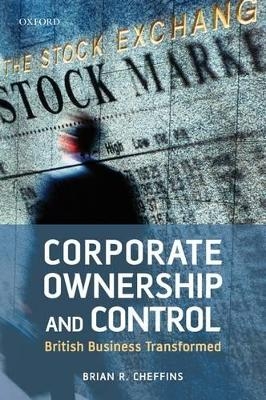
Corporate Ownership and Control
British Business Transformed
Seiten
2008
Oxford University Press (Verlag)
978-0-19-923697-8 (ISBN)
Oxford University Press (Verlag)
978-0-19-923697-8 (ISBN)
Much discussion on corporate governance assumes companies are owned and controlled separately, yet this is not the norm worldwide. This book explores the foundations of separation in UK companies, asking how the widely held company came to prominence and why and how the UK stock market came to be dominated by institutional shareholders.
The typical British publicly traded company has widely dispersed share ownership and is run by professionally trained managers who collectively own an insufficiently large percentage of shares to dictate the outcome when shareholders vote. This separation of ownership and control has not only dictated the tenor of corporate governance debate in Britain but serves to distinguish the UK from most other countries. Existing theories fail to account adequately for arrangements in the UK. Corporate Ownership and Control accordingly seeks to explain why ownership became divorced from control in major British companies.
The book is organized by reference to the 'sell side', which encompasses the factors that might prompt those owning large blocks of shares to exit or accept dilution of their stake, and the 'buy side', which involves factors that motivate investors to buy equities and deter the new shareholders from themselves exercising control. The book's approach is strongly historical in orientation, as it examines how matters evolved from the 17th century through to today. While a modern-style divorce of ownership and control can be traced back at least as far as mid-19th century railways, the 'outsider/arms-length' system of ownership and control that currently characterizes British corporate governance did not crystallize until the middle of the 20th century. The book brings the story right up to date by showing current arrangements are likely to be durable. Correspondingly, the insights the book offers should remain salient for some time to come.
The typical British publicly traded company has widely dispersed share ownership and is run by professionally trained managers who collectively own an insufficiently large percentage of shares to dictate the outcome when shareholders vote. This separation of ownership and control has not only dictated the tenor of corporate governance debate in Britain but serves to distinguish the UK from most other countries. Existing theories fail to account adequately for arrangements in the UK. Corporate Ownership and Control accordingly seeks to explain why ownership became divorced from control in major British companies.
The book is organized by reference to the 'sell side', which encompasses the factors that might prompt those owning large blocks of shares to exit or accept dilution of their stake, and the 'buy side', which involves factors that motivate investors to buy equities and deter the new shareholders from themselves exercising control. The book's approach is strongly historical in orientation, as it examines how matters evolved from the 17th century through to today. While a modern-style divorce of ownership and control can be traced back at least as far as mid-19th century railways, the 'outsider/arms-length' system of ownership and control that currently characterizes British corporate governance did not crystallize until the middle of the 20th century. The book brings the story right up to date by showing current arrangements are likely to be durable. Correspondingly, the insights the book offers should remain salient for some time to come.
Brian R. Cheffins is the S.J. Berwin Professor of Corporate Law at the Faculty of Law, University of Cambridge and is a Fellow of the European Corporate Governance Institute.
Preface ; Table of Cases ; Table of Legislation ; Chapter One: Setting the Scene ; Chapter Two: The Determinants of Ownnership and Control: Current Theories ; Chapter Three: The Sell Side ; Chapter Four: The Buy Side ; Chapter Five: Up to 1880 ; Chapter Six: 1880 - 1914 ; Chapter Seven: The Separation of Ownership and Control by 1914 ; Chapter Eight: 1914 - 1939 ; Chapter Nine: 1940 - 1990: The Sell Side ; Chapter Ten: 1940 - 1990: The Buy Side ; Chapter Eleven: Challenges to the UK System of Ownership and Control ; Index
| Erscheint lt. Verlag | 1.11.2008 |
|---|---|
| Verlagsort | Oxford |
| Sprache | englisch |
| Maße | 162 x 241 mm |
| Gewicht | 811 g |
| Themenwelt | Recht / Steuern ► EU / Internationales Recht |
| Recht / Steuern ► Wirtschaftsrecht ► Gesellschaftsrecht | |
| Recht / Steuern ► Wirtschaftsrecht ► Handelsrecht | |
| Wirtschaft ► Betriebswirtschaft / Management | |
| Wirtschaft ► Volkswirtschaftslehre ► Mikroökonomie | |
| ISBN-10 | 0-19-923697-6 / 0199236976 |
| ISBN-13 | 978-0-19-923697-8 / 9780199236978 |
| Zustand | Neuware |
| Haben Sie eine Frage zum Produkt? |
Mehr entdecken
aus dem Bereich
aus dem Bereich
Kommentar
Buch | Hardcover (2024)
C.H.Beck (Verlag)
CHF 306,55


